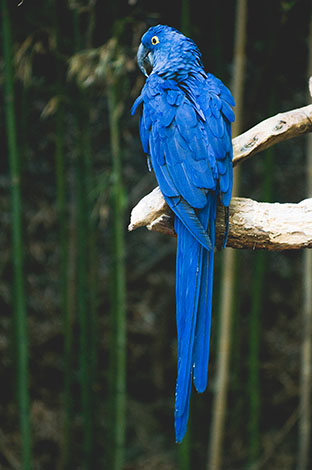Many parrot species can be taught to deposit their droppings in a designated place, just like a cat or dog. This is very handy if your parrot spends a lot of time outside the cage. It takes time and patience, but is worth the effort. As with all forms of bird training, positive reinforcement in the form of attention and treats helps a lot.
Smaller species such as budgies and parrotlets cannot be trained easily, as they need to evacuate their bowels too frequently. Younger birds of the larger varieties are in with the best chance of learning.

A clever bird like a Hyacinth Macaw can be house-trained just like a dog
- Toilet Training Commands for Parrots - Choose a word or phrase for the bird to learn, such as “Poo time!” – something short and distinct. Intonation is as important as the words themselves, and everyone talking to the bird will need to say it in the same way.
- Anticipating Toilet Time for Parrots - Parrots will usually start the day by producing droppings. They will also feel the urge after eating, or when removed from/put back in their cage. Keep an eye on the parrot to note its pooing routine. Look for the cues too, such as a flicking tail, a crouching posture or a ruffling of feathers.
- Starting Toilet Training - The trick here is to use the ‘step-up’ (see Parrot Training section of this guide). Once he’s on your hand, hold him over the area or object you wish to use as the parrot toilet (a certain corner of the cage, an area of newspaper, a waste-paper basket, plate or bowl, or even the household toilet). It’s important to make the bird realise that the location is as important as the object (to avoid him happily pooing on any old newspaper or plate!) Use the toilet training command, and when the droppings appear, lavish him with praise, finger-strokes and a treat. It will take time for the connection to be made, so keep at it. Never shout at your parrot if he poos in the ‘wrong’ place.
- Reinforcing Toilet Training - A bird who has learnt to ‘step up’ and poo on command may still relieve himself elsewhere when the urge is upon him. Ideally he will come to realise that going to the toilet under your command brings benefits that normal pooing does not. Eventually he will go to the toilet area instinctively, without the constant need for attention (although it may take a while to stop him shouting for you each time he needs to go – the promise of tickles and treats is a hard thing to put aside!) Larger parrots don’t need to poo as many times in a day as smaller species, so will be easier to train: if you assist them with the ‘step up’ procedure as soon as they leave the cage, you won’t have to worry about more toilet breaks for an hour or so.
Comments
There are no comments just yet